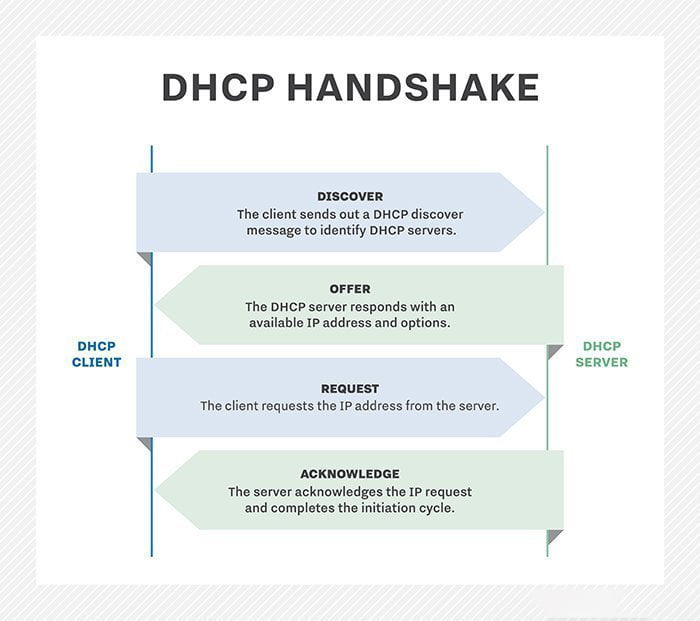DHCP servers usually assign each client with a unique dynamic IP address, which changes when the client’s lease for that IP address has expired. There are many enterprise companies who are still using DHCP for IPv4 on their routers/switches.
WHAT IS A DHCP SERVER?
A DHCP Server is a type of network server that automatically provides and assigns IP addresses, default gateways, and other network parameters to client devices. This server relies on a protocol known as Dynamic Host Configuration Protocol (DHCP) to respond to broadcast queries from clients.
By using a DHCP server, clients can automatically receive the required network parameters needed to communicate on the network. Without a DHCP server, network administrators would need to manually set up each client that joins the network, which can be time-consuming and challenging in large networks. DHCP servers typically assign each client a unique dynamic IP address, which changes when the client’s lease for that IP address has expired.
When to use a router/switch as your DHCP Server
Numerous large-scale enterprises continue to depend on Dynamic Host Configuration Protocol (DHCP) for managing Internet Protocol version 4 (IPv4) on their networking devices such as routers and switches. This responsibility is typically entrusted to the network administrator, tasked with promptly establishing DHCP capabilities even in the absence of a dedicated DHCP server.
Fortunately, the majority of modern routers and switches are equipped with DHCP server functionality. This encompasses a DHCP client component responsible for acquiring an IPv4 address for the device’s interface from an upstream DHCP service. Additionally, these devices offer DHCP relay functionality, which facilitates the transmission of UDP DHCP messages between clients within a local area network (LAN) and an external DHCP server. Furthermore, some of these networking devices also include a built-in DHCP server capable of directly managing and responding to DHCP requests.
This integration of DHCP features within routers and switches underscores their adaptability and utility in fulfilling DHCP-related tasks, streamlining network administration processes within enterprise environments.
However, using a router/switch as a DHCP server does have its limitations.
- Running a DHCP server on a router/switch consumes resources on the network device, and the DHCP packets are handled in software (not hardware-accelerated forwarding).
- This makes the practice unsuitable for a network with a large number (> 150) of DHCP clients.
- The router/switch DHCP server also does not support dynamic DNS, meaning it cannot create an entry into DNS on behalf of the client based on the leased IPv4 address.
- Additionally there is no easy way to manage the scope and see the current DHCP bindings and leases across multiple routers, requiring the administrator to log into each switch/router individually for DHCP binding information.
- Furthermore the DHCP service running on a router/switch is not integrated with IP address management (IPAM) for address tracking and scope utilization or security forensics.
- There is also no high availability or redundancy of the DHCP bindings, which could cause problems if the current DHCP server and default gateway fails.
- Lastly it is more difficult to configure DHCP options on a router/switch platform.
The Benefits of a dedicated DHCP Server

Utilizing a centralized DHCP server is a superior approach compared to utilizing DHCP on a router/switch, especially in network environments that require simultaneous support for DHCP for IPv4 and DHCP for IPv6. Nearly all DHCP server vendors offer support for both protocols, enabling the utilization of a unified management interface for IPv4 and IPv6. The advantages of employing DHCPv6 demonstrate why enterprises find it beneficial.
By implementing a centralized DHCP server, administrators can effortlessly manage and monitor DHCP configurations, DHCPv6 options, and the availability of IP addresses. DHCPv6 also facilitates more efficient address assignment, configuration, and administration. Furthermore, it allows the provisioning of additional configuration parameters to clients beyond solely offering IP addresses. Additionally, DHCPv6 aligns flawlessly with Internet Protocol version 6 (IPv6), which provides a significantly larger address space compared to IPv4, making it exceptionally well-suited for extensive networks.
In summary, the utilization of a centralized DHCP server with DHCPv6 presents a more scalable and efficient approach to IP address management in enterprise networks.
- Integrating a DHCPv6 server into your IP Address Management (IPAM) system for IPv6 provides visibility to the IPv6-enabled client nodes, which is crucial for efficient management of IP addresses in an enterprise network. The same level of functionality is desirable for IPv4 as well.
- As the availability of IPv4 addresses decreases, it’s important to keep track of DHCP scopes and determine adequate lease times for the growing number of BYOD systems joining the networked environment.
- DHCP servers offer logging and management interfaces that help administrators manage their IP address scopes. Organizations require an accounting of what’s on their network, regardless of the IP version being used. DHCP servers can also provide redundancy and high availability. If one DHCP server fails, the clients preserve their current IP addresses and don’t cause an interruption for the end-nodes.
- Organizations prefer a DHCPv6 server that has been tried and tested. For instance, the Infoblox DHCPv6 server has been certified as “IPv6 Ready” by the USGv6 certification laboratory. Such a certification ensures that the DHCPv6 server is compliant with the latest IPv6 standards and can offer reliable and efficient service to enterprise networks.
As organizations start to adopt IPv6, it is recommended that they move their DHCP for IPv4 scope from routers/switches to a reliable DHCP server infrastructure. This shift should ensure that DHCP operates consistently for both protocols. Enterprises should leverage a centralized DHCP server that supports both IPv4 and IPv6 to allocate addresses to client devices.

